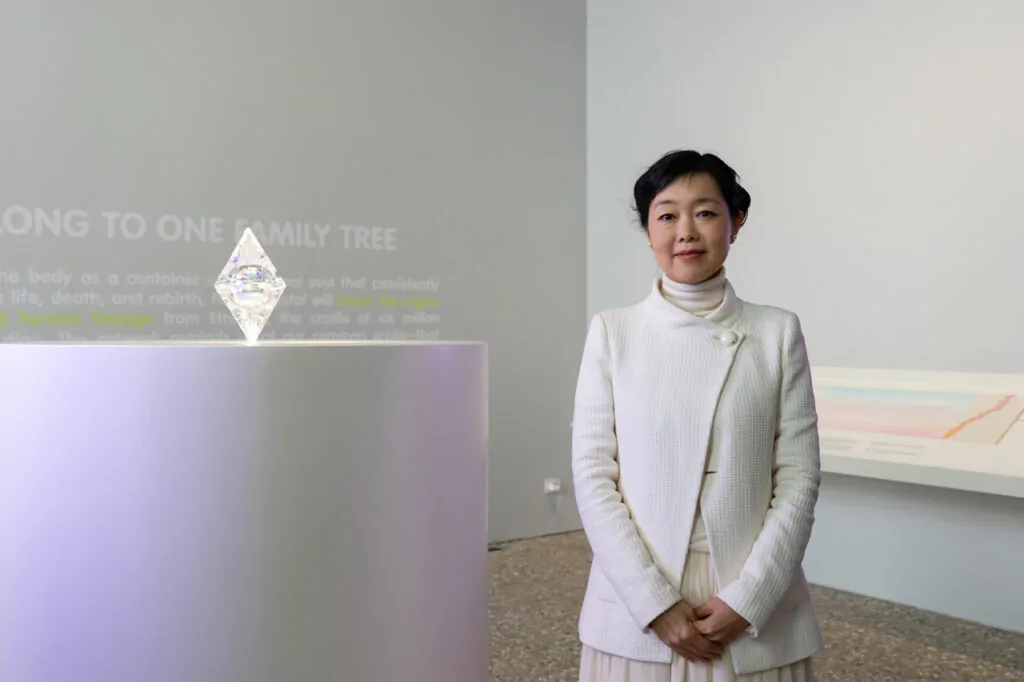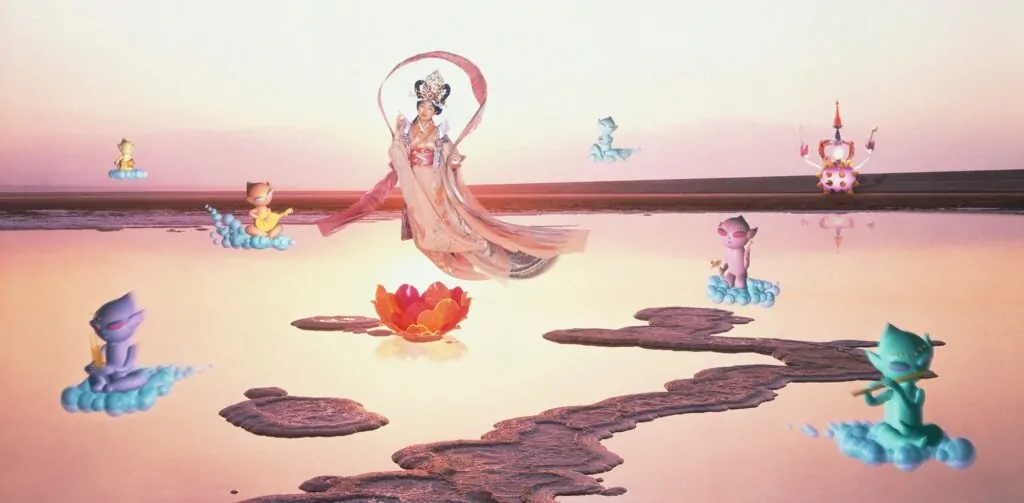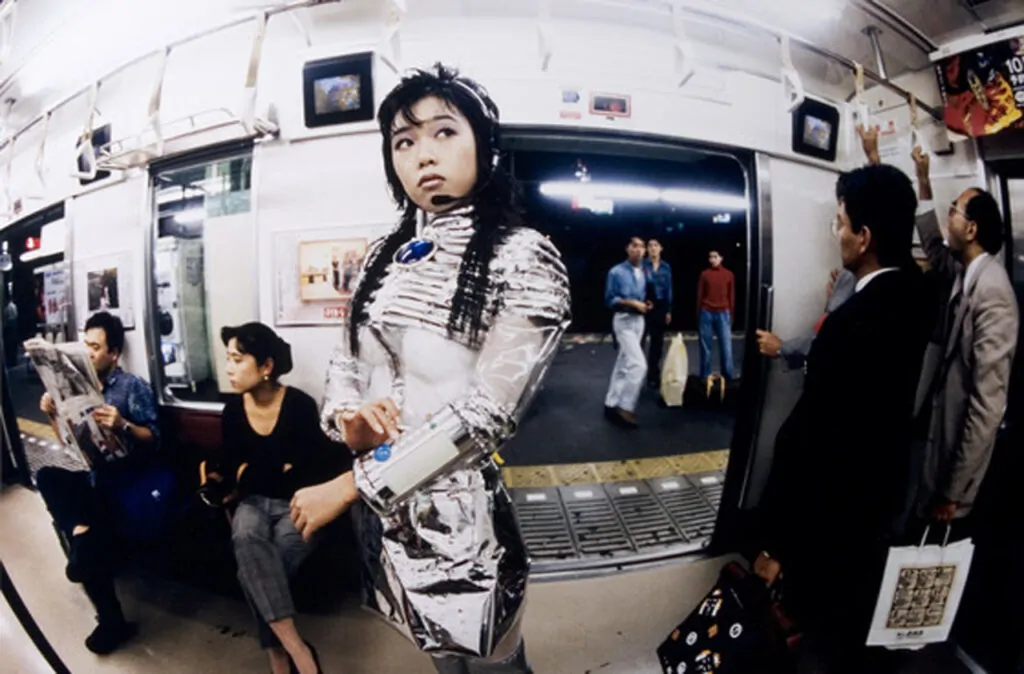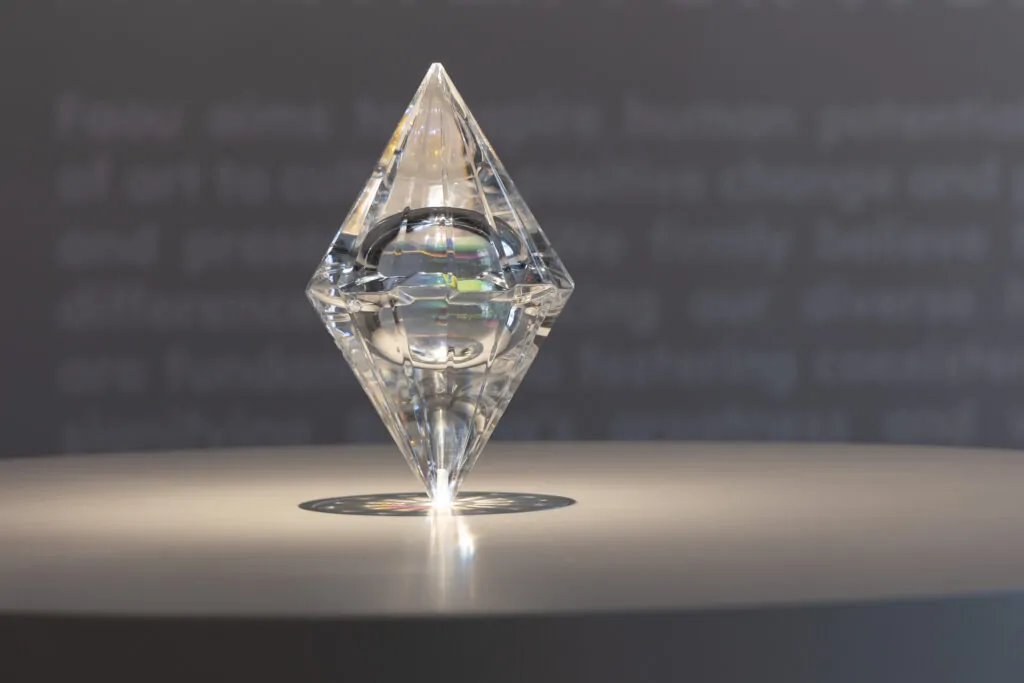In Mariko Mori’s luminous fusion of tradition and futurism, a search for meaning unfolds—balancing the weight of mortality, spirituality, and the digital age.
We walk a tightrope between existence and illusion, striving to uncover meaning in the noise. The shadowy distortions of technology hang over us as we grapple with life’s endless questions—its trials and what lies beyond mortality. For me, the practice of revered, multidisciplined Japanese artist Mariko Mori feels like a pilgrimage into the still, unsettling eye of these enigmas.
Heralded as one of Japan’s most influential artists, Mori is known for her pioneering multimedia work that merges cultural heritage, spiritual enlightenment, gender roles and technology with futuristic visions.

The themes in my work have gradually shifted from societal concerns to more spiritual, and this shift has naturally influenced the technique and media I employ.
Mariko Mori
Born in Tokyo in 1967, Mori initially pursued fashion design at Bunka Fashion College and worked as a fashion model. Raised in a household with a father who was an inventor and a mother who was a historian of European art, she was immersed in an environment of innovation and historical scholarship—an intriguing duality that shapes her work.
In 1989, Mori moved to London to study at the Byam Shaw School of Art and the Chelsea College of Art and Design, graduating in 1992. She then refined her craft further at the Whitney Independent Study Program in New York. While in New York, her interest in traditional Japanese culture deepened, laying the foundation for a vibrant body of work shaped by expressive freedom and diverse cultural influences.
Mori views technology as a medium to explore altered states of consciousness and the boundaries of identity, blending ancient myths with futuristic concepts. Drawing from Japanese heritage, Eastern mythology, and Western modernity, she constructs intricate worlds populated by fantastical deities, robots, and alien beings. These figures, often portrayed by Mori herself, fill her video and photographic works with a sense of transcendence and hybridised reality.
Long before Tesla’s vision of humanoid robots, Mori was already exploring the fusion of humans and machines in works like Play with Me (1994), where she adopts the role of a hypersexualised cyborg outside a Tokyo toy store. In these roles, she becomes a symbol of hybridised futurism, blurring the lines between the organic and the synthetic at a time when the world was turning its focus to the millennium and the hopes and dreams of technological advancements.
Mori’s fascination with consciousness and death traces back to an unsettling experience of sleep paralysis in her early twenties, where she was trapped for hours in an ambiguous state, questioning whether she was alive or had already crossed the threshold of the deceased. This surreal moment of suspended reality lingers in her work, infusing each piece with a haunting curiosity about existence and what lies beyond. As she hones her craft, her explorations have increasingly embraced spiritual and transcendental themes, drawing from her Buddhist and Shinto heritage.
During the 47th Venice Biennale in 1997, Mori showcased two works: the photo collage Empty Dream (1995) in the Japanese Pavilion and the 3-D video installation Nirvana (1997) in the Nordic Pavilion.
In 2010, Mori founded the Faou Foundation, an institution dedicated to promoting art and fostering a connection with the environment, particularly through public installations in remote natural settings. In her latest body of work, part of Mori’s ongoing mission with the Faou Foundation, she invites us to consider world peace and shared humanity through her immense Peace Crystal installation. Initially located in the garden of Palazzo Corner della Ca’ Granda, Venice, Italy, the piece will later find its permanent home in an Ethiopian cave.
Standing five feet six inches tall, Peace Crystal draws on Buddhist philosophy, symbolising the body as a vessel for the eternal soul’s cycle of life, death, and rebirth. The striking installation resembles a multifaceted pyramid, refracting a spectrum that dances across its polished surfaces. At its apex, a beam of light reaches upward, establishing a celestial connection, as if striving for otherworldly domains. For Mori, the installation symbolises an evolution of spirituality and intelligence, inviting viewers to contemplate dualities of presence and absence, physicality and spirituality.
Over a long and successful career, Mori has shaped discussions on universal themes of interconnectedness, life, death, reality, and the role of technology in human experience. Her work serves as a clarion call, urging us to discover profound meaning at the intersections of life, technology, and spiritual enlightenment.
Hi Mariko, thanks for speaking with us. Could you start by sharing your journey into the arts and what inspired you to pursue a career as an artist?
Mariko Mori: In my early twenties, during the mid-1980s, I encountered installation art in London. I was deeply inspired by the freedom of expression it allowed within a spatial context. There were also no limitations on materials, and I realized the potential to create entirely new dimensions through this form.
Your work blends Japanese tradition, pop culture, and futuristic aesthetics. How has your journey from Japan to New York and London influenced your practice, and can we delve into the recurring themes of cultural fusion, spirituality, and technology in your work?
Mariko Mori: New York is a city of immense diversity and multiculturalism, which constantly questions one’s cultural identity. This environment has deepened my interest in my own traditional culture.
It is a progressive place where diverse cultures collide, merge, and give birth to new forms of expression. However, new ideas may be quite challenged to survive, even pop culture without a core ideology can easily fade away like a fleeting trend. Similarly, ever-evolving technology which reflects society’s desires cannot contribute meaningfully to society without a foundational philosophy. How we harness technology depends on having a clear vision of the future. As artists, I believe one of our missions is to propose such a vision.

Throughout your career, you’ve shifted from photography and performance to large-scale installations and digital technology. Can you discuss how this evolution in materials reflects changes in your conceptual focus and the new directions it has opened for your work?
Mariko Mori: The themes in my work have gradually shifted from societal concerns to more spiritual, and this shift has naturally influenced the technique and media I employ. As I sought ways to articulate my concepts more deeply, I have explored different technology and materials. There are no limits to the ways in which art can be achieved, and I have worked to develop new technologies that didn’t previously exist, continually pushing the boundaries of my artistic expression.
Many of your projects, like Wave UFO, explore the relationship between spirituality and advanced technology. How do you navigate the balance between ancient spiritual philosophies and the futuristic, hyper-modern worlds you create, and what drives this connection in your work?
Mariko Mori: Traditional culture, Buddhist philosophy, and Eastern thought are elements that have been passed down through generations and must continue to be inherited by future ones. While the essence of these teachings and primordial wisdoms remains universal, societal values evolve over time.
Many traditions are often preserved in museums, but their relevance can often be lost in modern society. I believe that these timeless wisdom should remain alive and active in today’s world, and communicating them through my work is one of my missions as an artist.

Photographs
Fuji super gloss print, wood, pewter frame
Framed: 27 x 40 3/4 x 1 7/8 in. (68.58 x 103.51 x 4.76 cm)
Gift of Peter Norton and Eileen Harris Norton, Santa Monica in honor of the museum’s 40th anniversary (M.2005.137.3)
© Mariko Mori/Artists Rights Society (ARS), New York
Can we speak about crucial works such as Birth of a Star and Play with Me, where you portrayed cyborg-like figures? What does this recurring theme of the cyborg signify for you in terms of gender, identity, and humanity’s evolving relationship with technology?
Mariko Mori: I produced these works in the mid-1990s, during a time when hyperreality—a cyber reality, especially within Japan’s “otaku” culture—was becoming increasingly prevalent. I wanted to explore a society where this artificial world was becoming more real than reality itself. “Empty Dream” (1995) particularly reflects this concept.
Your work often presents futuristic or otherworldly visions that look beyond the present moment. What role does the future play in your creative process, and what message do you hope to convey about humanity’s relationship with technology, spirituality, and the environment?
Mariko Mori: Until the Neolithic era, the world was not fragmented. Each region developed diverse civilizations and cultures along different timelines, but these differences led to wars, resulting in numerous borders—walls—being erected across the Earth. Humanity, which evolved in Africa and spread worldwide, can essentially be considered a single family; however, the human world became conceptually divided through history.
Yet spiritually, we have always been in a state of “Oneness.” Even quantum cosmology depicts a universe where life and death recur in an interconnected continuum. It seems that advanced technologies are now endeavoring to reconnect our fragmented world. I believe this represents societal will and it serves the direction toward which we are heading. Through my artwork, I aspire to advocate and share a vision of “Oneness.”

Photo by Marta Buso
Courtesy Faou Foundation
In 2010, you founded the Faou Foundation to promote art that fosters a connection with the environment, particularly through public installations in remote natural settings. Could you share more about the essence of the foundation and what inspired you to establish it?
Mariko Mori: There is a belief system that has been passed down since the Jomon period (1400-300BC) and became more grounded during the Kofun period (5th to 7th Century) in Japan. This belief, known as animism, venerates the deities of the natural world. I think that the preservation of Japan’s natural environment today is deeply rooted in this belief, which continues to influence modern society.
I believe that contemporary art has the potential to serve a significant role in conserving the natural environment. Contemporary art has become more and more a universal language, and by dedicating monumental installations that express reverence for nature, we can contribute to environmental preservation for future generations. One of our goals is to engage with local communities and, together, explore ways to coexist with the natural world.
In your latest installation, Peace Crystal, you explore the human body as a vessel for the eternal soul, drawing on Buddhist themes of life, death, and rebirth. How does the installation’s focus on physicality—particularly the crystal’s height and balance—serve as a metaphor for humanity’s spiritual evolution and the pursuit of peace?
Mariko Mori: Among living beings on Earth, humanity is unique in its verticality, with a body capable of receiving energy from both the celestial and terrestrial. A teaching I once learned from Native Americans says, “The Earth that nurtures life is the mother, and the sky is the father.” Just as trees grow upward toward the sky, I feel that our souls are nurtured and expand, reaching towards greater spiritual growth. I believe humanity’s true purpose is to bring peace to Earth and it is my wish that Peace Crystal could remind us of this.
At the core of the sculpture levitates a sphere symbolizing the eternal soul. Encircling this sphere are luminous bubbles that evoke the imagery of galaxies, shimmering with ethereal brilliance. According to Buddhist philosophy, the soul is intrinsically connected to all dimensions and unified with them. Thus, the soul transcends the physical body; it is neither materially born nor does it perish but exists eternally. To represent the concept of the soul’s antimatter, I employed the technique of dichroic vacuum deposition, endowing the sphere with an iridescent, spectrum luminescence. Additionally, I utilized a solar light-transmitting system to illuminate the work with visible rays of sun. I believe this work engages in an intense dialogue with the viewer’s subconscious mind.

Photo by Massimo Pistore. Courtesy of the Artist, Faou Foundation and Palazzo Diedo Berggruen Arts & Culture
You’ve described the moment humans stood upright as pivotal for the development of intelligence and spirituality, represented in Peace Crystal by its balance. How does this idea of verticality and energy flow between celestial and terrestrial realms reflect your broader exploration of interconnectedness in the universe?
Mariko Mori: Among living beings on Earth, humanity is unique in its verticality, with a body capable of receiving energy from both the celestial and terrestrial. A teaching I once learned from Native Americans says, “The Earth that nurtures life is the mother, and the sky is the father.” Just as trees grow upward toward the sky, I feel that our souls are nurtured and expand, reaching towards greater spiritual growth. I believe humanity’s true purpose is to bring peace to Earth and it is my wish that Peace Crystal could remind us of this.
At the core of the sculpture levitates a sphere symbolizing the eternal soul. Encircling this sphere are luminous bubbles that evoke the imagery of galaxies, shimmering with ethereal brilliance. According to Buddhist philosophy, the soul is intrinsically connected to all dimensions and unified with them. Thus, the soul transcends the physical body; it is neither materially born nor does it perish but exists eternally. To represent the concept of the soul’s antimatter, I employed the technique of dichroic vacuum deposition, endowing the sphere with an iridescent, spectrum luminescence. Additionally, I utilized a solar light-transmitting system to illuminate the work with visible rays of sun. I believe this work engages in an intense dialogue with the viewer’s subconscious mind.

Courtesy of the Artist, Faou Foundation and Palazzo Diedo Berggruen Arts & Culture
As your practice evolves, what future directions are you excited to explore? Are there any emerging technologies or philosophical concepts that are inspiring your current or upcoming projects?
Mariko Mori: In my early twenties, after my father passed away, I embarked on a journey spanning over 30 years to explore the fate of his soul from various multidimensional perspectives. My extensive studies have encompassed theology, Buddhism, ancient civilizations, the Neolithic era, and theoretical astrophysics, among other fields. While these explorations have gradually brought me closer to an understanding of the essence, the most decisive moment was a profound mystical experience—an encounter with a Great Light, which could be referred to as the Creator in Christian terms or as in Dōgen’s (13th century zen monk) teachings, “光明” (Kōmyō).
In 1999, I endeavored to visualize this Light for the first time in my work “Dream Temple”(1999). However, the magnitude and sublimity of this Great Light remains an immense challenge for me even today. I am committed to continuing my efforts to give form to this Light, and through Faou Foundation’s projects, I aspire to create works that revere and honor nature, dedicating them to the world.
Art is an experience to be both observed and profoundly felt. This is because the viewer not only perceives the work visually but also apprehends it on a subconscious level. Art possesses the extraordinary ability to convey that which transcends verbal articulation. Its power is limitless, capable even of transcending time and space. As an exceptionally potent force in this world, art has immeasurably enriched my life through the act of creation, for which I am deeply grateful.
Lastly, could you share the philosophy that guides your art? How do you see the role of art in your life and its importance in shaping your career and broader worldview?
Mariko Mori: In Japan, there exists a spiritual tradition known as “Iwakura.” These are sacred sites where the deities of nature temporarily descend upon rocks. It is conceivable that our ancestors were attuned to the inherent energies within these landing stones. Similarly, artworks contain an intangible energy imbued within their materials—something unseen that resides within them. I have unwavering faith in this power and am committed to continuing my creative endeavors, trusting in the path that has naturally guided me.
©2024 Mariko Mori





